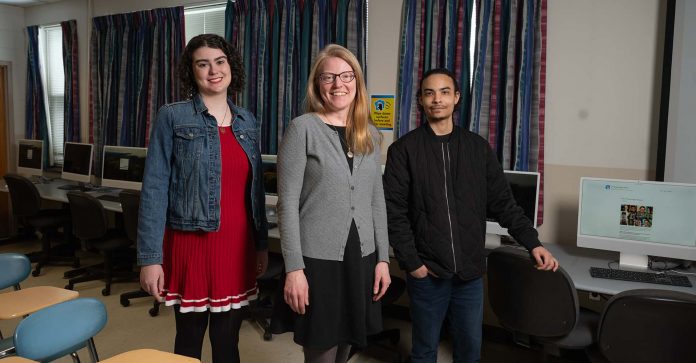The student journalists at Southern aren’t only being published in the Southern News, the university’s student newspaper.
Four Southern students recently have seen their bylines printed in Connecticut Public, the CT Mirror, WSHU, and the Hartford Courant as the result of a new statewide venture, the Connecticut Student Journalism Collaborative, an organization sponsored by journalism faculty at college and university campuses across the state and supported by local media partners.
According to its website, the collaborative “curates the work of student journalists … with two big goals: Provide coverage of a wide range of under-reported stories and issues that matter to Nutmeggers, and showcase the work of the state’s best emerging journalists.”
Junior Avery Martin’s story in the Courant about young people deciding not to vote in the 2024 presidential election inspired 10 letters to the editor. She previously wrote a story talking to first-time voters, with reporting help from a student at Central Connecticut State University.
“It’s really crazy, having two articles and one having such a big reaction,” said Martin, who’s from Southington and hopes for a career as an investigative journalist. “First of all, the Hartford Courant is so well known, and it’s an honor to be published in a state publication.
“It’s great for my résumé and for my future, and I’m very, very thankful that I had this opportunity,” she said. “It’s definitely a huge boost to my confidence in terms of my writing.”
Martin said she was surprised to find so many students deciding to sit out the election that gave Donald Trump a second term.
“I was a little bit surprised at how easy it was to find quite a few people who weren’t voting,” she said. “Especially because I was reaching out on a college campus, I thought there would be a higher amount of people voting just because of the demographic. … But it seems like there was a fair amount of people who weren’t voting and were willing to talk about it, so I was surprised with that.”
According to Jodie Gil, professor of journalism and one of the founders of the collaborative, the two colleges joining Southern and Central are the University of Connecticut and the Connecticut State Community College in Manchester. Quinnipiac University and the University of New Haven have also gotten involved.
Gil attended a workshop in June 2023 at the University of Vermont, whose Center for Community News is “studying how students are helping to fill the gaps with changes in the local news industry,” she said.
“Across the country, we’re seeing newspapers shut down. We’re seeing staffs getting cut,” she said. Another issue is that there are few internships available for undergraduates at newspapers and broadcast outlets.
“And so this group at the University of Vermont has been studying how are student journalists filling in those holes in many different ways?” Gil said.
The Connecticut Student Journalism Collaborative was born out of those talks; it launched in spring 2024. The online publications and the Courant have reacted positively.
“It’s more of a streamlined process for us to get our stories to them, versus independent professors trying to reach out to people at those papers or stations and trying to pitch stories that way,” Gil said. “It all funnels through our site … Connecticut Community News.
The experience is invaluable to the students, Gil said.
“As a student learning to do this work, it’s difficult work. I think journalism is difficult to do,” she said. “I think you have to be savvy in terms of talking to people, but also understanding the larger context, understanding how to put stories together.”
The students take photos to go with their stories as well, Gil said.
Brandon Cortés of Bridgeport, who will graduate this fall, wrote a story for his data journalism class about how ridership on CT Transit buses dropped after COVID-era free fares ended. It was published by Connecticut Public and the CT Mirror, where it was among the most-read stories the week it was published, with more than 7,000 views.
“Connecticut Public told me, ‘Hey, this gathered a lot of reaction. You did a very good job,’” Cortés said.
While he also reports for Southern News, “It’s different when you get a story published by something or someone who is not part of the university, someone that’s not local,” he said.
“This story was a very solid story,” said Eric Aasen, executive editor of Connecticut Public. “Brandon ended up applying for an internship with us, and … he ended up interning with us last year.” Cortés wrote stories for broadcast and the website during his internship.
Aasen said the students write stories with a different perspective than adult professionals have.
“It’s helpful to have those contributions to provide context so that our reporters can focus on their other stories, but also these students’ stories also give us a glimpse into parts of the state that we may normally not be getting to,” Aasen said. “A lot of these other stories are about sometimes campus issues or issues going on in towns that we may not be spending a lot of time in.”
Harriet Jones, editor and coordinator of CT Community News, said the collaborative recently became a non-profit organization. She serves as executive director. Among her duties will be seeking grants to support the project.
“Essentially, we want to build more of a workforce pipeline, because we have phenomenal journalism education in this state, spread over many different institutions,” Jones said.
“We also have phenomenal media outlets, but we don’t have enough connections between them, because … there’s fewer and fewer internships. Newsrooms have become more stretched,” she said. For journalism students, “There isn’t a way for them to showcase themselves.
“So that’s what we are trying to build is that pipeline whereby students can get published, they can get clips for their portfolio of professionally published work, not just student-published work,” Jones said. “That makes them a more attractive proposition when they go on the job market.”
The publications appreciate the students’ story ideas, Jones said.
“They will sometimes give suggestions, but they also say it’s really great for them to be able to see what the students are coming up with, because … it’s a very diverse group of students that we work with. And they’re often quite embedded in their own communities,” she said.
Jones said the collaborative is helping to connect journalism education and the workplace.
“It’s difficult. I mean, obviously there’s fewer positions anyway, but there’s not enough visibility to what talent is being produced in this state,” she said. “There isn’t enough of that workforce pipeline.
“We aim to be that kind of connective tissue between the journalism departments, the communications departments and the talented writers,” Jones said. “It’s also about keeping homegrown talent here. … We should be looking inside the state, because there’s talented people coming up through the system.”


